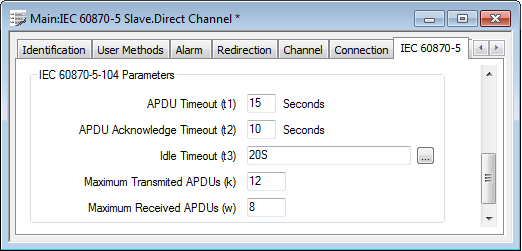When a Slave Channel is configured to use an IEC 60870-5-104Protocol Type (see Specify the IEC 60870-5 Communications Protocol), you need to configure these properties on the IEC 60870-5 tab:

- APDU Timeout (t1)—Use to specify the maximum amount of time, in seconds, that the slave outstation (ClearSCADA) waits for a transmitted Application Protocol Data Unit (APDU) to be confirmed as received by the SCADA master.
- APDU Acknowledge Timeout (t2)—Use to specify the maximum amount of time that the slave outstation (ClearSCADA) can remain idle after receiving an APDU, before it has to send a response to the SCADA master to indicate that it has received the APDU successfully.
- Idle Timeout (t3)—Use to set the slave outstation to transmit a test frame at specified intervals (via the channel). By transmitting a test frame, the slave outstation can determine if the channel is still available after a prolonged period of communications inactivity (no data being sent via the channel).
- Use the Idle Timeout field to specify the maximum amount of time, in seconds, that the Link Layer can remain idle. Enter the value in the OPC Time Format, for example, 20S for 20 seconds. If the Link Layer is idle for longer than the Idle Timeout, the slave outstation will send a test link frame to an outstation on this channel.
- Maximum Transmitted APDUs (k)—Specify the maximum number of unconfirmed APDUs that the slave outstation (ClearSCADA) is to transmit via this channel, before it waits for acknowledgment from the SCADA master that those APDUs have been received successfully.
- Maximum Received APDUs (w)—Specify the maximum number of APDUs that the slave outstation can receive on this channel, before it sends confirmation that it has received those APDUs successfully.